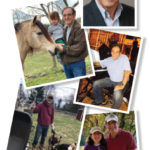Although an animal lover, much of her satisfaction comes from her garden, which includes heirloom tomatoes, garlic, potatoes, onions, sweet corn, different types of squash, beets, kale, chard, and basil and other herbs. The whole idea, she says, is to grow and sell a wide variety of vegetables that people can use to create fresh, healthy and interesting meals.
She describes a typical summer weekend that could be the focus of a Norman Rockwell painting: On Saturday, she and her husband wake up at 6 a.m. to pick vegetables that he sells that day at the nearby farmer’s market, and then they eat breakfast with their children. For the rest of the day, Dr. Kahlenberg tends her garden, doing everything from weeding to planting to moving crops. When her husband returns around 4 p.m., she helps him unload the truck and feed the wilted greens to the pigs and chickens.
On Sundays, the farm is open to visitors. Children can hold baby chicks and pet sheep while their parents scout out which vegetables they want to buy and serve for dinner.
During the winter months, the farm is less busy. Most of her time is spent delivering and vaccinating “our babies,” she says, mainly referring to piglets, lambs and calves.
Teaching Lessons, Trading Stories
The farm is an active and lively home for 24 sheep, five cows, two steer, 80 chickens that lay eggs, 200 others referred to as “meat” chickens, 11 pigs, including a large black hog who’s an endangered farm animal, and—during summer—20 turkeys, not to mention five barn cats and the family dog, Emma, an English Shepherd.
“You start to learn the personalities of the animals,” says Dr. Kahlenberg. “We keep the breeding animals for a long time and give them names. Although you don’t want to get cuddly with a 600 lb. sow; that would be dangerous.”
She believes the farm is a master teacher, especially for her young children. They’re not only learning responsibility, but also compassion, she says, explaining that it’s a farmer’s job to provide animals being raised for meat with a healthy and happy life before they end up on the dinner table.
Likewise, it’s important to purchase quality food—without antibiotics—for farm animals, which is very costly. She points to a truckload of quality feed for pigs. The month’s supply is almost equivalent to a mortgage payment—approximately $1,000.
“Operating a small farm like ours is not easily financially viable without one person working outside the home,” she says.


